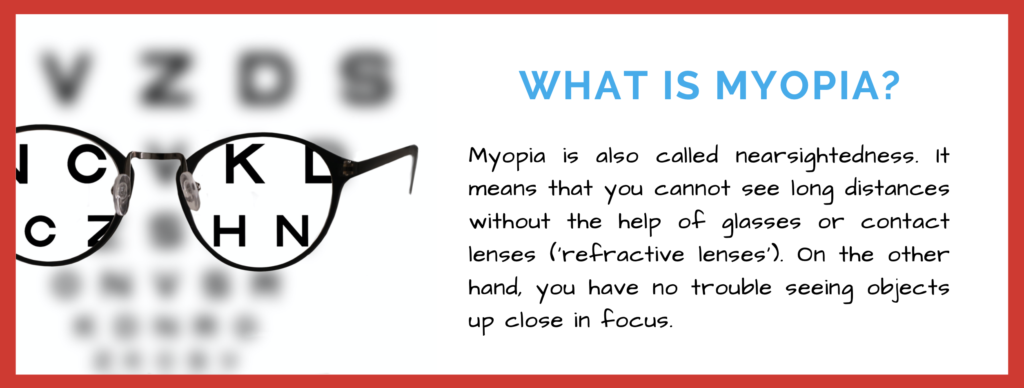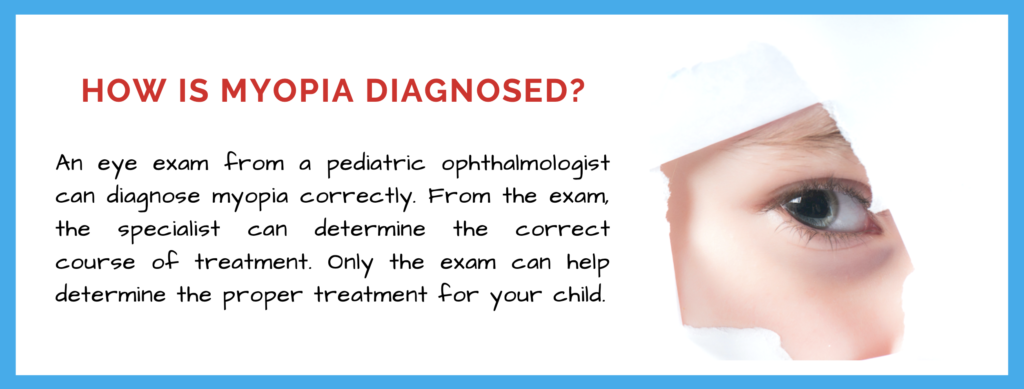When you hear the statistics, you might think it’s time to panic: The rate of Myopia is rising worldwide at alarming rates. For example, in China 60 years ago, only 15% of the population was nearsighted – now, nearly 90% of children and teenagers are affected.
In the US, 25% of the population was myopic in the early 70s, but it’s over 40% now. Is it a health crisis? Maybe, but it’s a treatable one. Our pediatric eye doctors are here to help you understand what Myopia is and how we can help you.
What is Myopia?
Myopia is also called nearsightedness. It means that you cannot see long distances without the help of glasses or contact lenses (‘refractive lenses’). On the other hand, you have no trouble seeing objects up close in focus.
For example, children cannot see objects that are at a distance, such as a classroom school board. It may impact their ability to be successful in school due to vision limitations.
If not corrected, Myopia can also lead to more severe eye concerns. Myopia also tends to worsen as the child grows older.
There are two different types of Myopia.
High Myopia
High Myopia is more serious and occurs when the eyeball grows more than it is supposed to from front to back. High Myopia increases the risk for other conditions such as a detached retina, cataracts, and glaucoma.
Degenerative Myopia
Degenerative Myopia is not as common and is an inherited condition. The eyeball grows longer, more quickly and symptoms usually worsen during the teenage years. Degenerative Myopia is also associated with an increased risk of a detached retina and glaucoma if left untreated.
What Causes Myopia?
Myopia is caused by changes to the shape of the eye globe — specifically elongation or lengthening. This impairs the eye’s ability to properly focus light that is being projected on the retina. Instead of focusing it right at the retina, it focuses it in front of the retina.
Myopia’s sister – hyperopia, or farsightedness – is the opposite. Because the eye globe is shortened, the light focuses behind the retina.
Children whose parents have Myopia are more likely to develop it, but it isn’t a cause-and-effect situation.
What are the Symptoms of Myopia?
Some children’s ophthalmologists suspect that screen use has something to do with the rise in diagnosis rates, as well.
If you suspect your child may have Myopia, look for these symptoms:
- Persistent need to squint or close eyelids to see clearly
- Headaches (due to eyestrain)
- The need to sit closer to the television, movie screen, or the front of the classroom
- Holding books very close while reading
- Not noticing distant objects, like street signs
- Blinking excessively
- Rubbing eyes frequently
Even if your child isn’t showing symptoms, it’s worth having an eye exam at age six and, as needed, a children’s eye doctor to ensure that their eye health is in order.
How is Myopia Diagnosed
An eye exam from a pediatric ophthalmologist can diagnose myopia correctly. From the exam, the specialist can determine the correct course of treatment.
Most of the time, contacts, eye drops, or glasses are effective options, though surgery may be recommended in severe cases. Only an exam can help determine the proper treatment for your child.
What is the Treatment for Myopia?
Children with Myopia do have a solution – glasses or contacts. For younger children, glasses are a better option, as contacts can be challenging to use. Our optical shop in Livingston has a wide range of children’s glasses to ensure that they find something they like and will wear.
What’s interesting is that researchers are starting to investigate other ways of treating Myopia and stopping it from worsening. Although there is still no cure, solutions like atropine eye drops, multifocal contact lenses, orthokeratology, and multifocal eyeglasses are options. Our children’s eye doctor can advise you if any of these solutions would be possible for your child.
Is Myopia Preventable?
Though myopia is inherited, some options can help in the progression. The following are some factors you can control that can help the conditions:
- Limit the number of near vision tasks for the child and offer frequent breaks
- Bring your child outdoors every day as it allows the eyes to relax. 60-80 minutes is recommended by pediatricians daily.
Be sure to see a pediatric eye doctor regularly to monitor the condition’s progression and make any adjustments if needed.
Learn More About Pediatric Eye Associates
Whether your child has Myopia or hyperopia or is suffering from other vision problems, our pediatric ophthalmologists in NJ at Pediatric Eye Associates are here to help.
Our exceptional doctors, Amy Lambert, MD, and Rachel Bloom, MD, are board-certified pediatric ophthalmologists. Dr. Lambert, the Pediatric Eye Associates, LLC, is also a board-certified strabismus surgeon, and Dr. Bloom is also fellowship-trained.
Our child eye doctors are experts at meeting your children’s eye and vision needs. We pride ourselves on the results we achieve with our patients, and we believe the key is not just our medical expertise but also attitude and patience with the children
Our motto is “to provide the highest quality eye care for children in a setting that is comfortable and reassuring.”
From diagnosis to frame selection and fitting at our kids’ optical shop in Livingston, we have everything your child needs to see better!
We are always happy to answer any questions you may have. Contact us if you’d like to schedule an appointment at our office or if you have any questions regarding Pediatric Eye Associates. We are looking forward to seeing you soon!
The material contained on this site is for informational purposes only and DOES NOT CONSTITUTE THE PROVIDING OF MEDICAL ADVICE, and is not intended to be a substitute for independent professional medical judgment, advice, diagnosis, or treatment. Always seek the advice of your physician or other qualified healthcare provider with any questions or concerns you may have regarding your health


